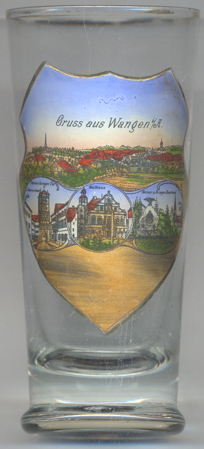

|
| DEUTSCHLAND | GERMANY |
| Bundesland: Baden-Württemberg | |
| Regierungsbezirk: Tübingen | |
| Landkreis: Ravensburg |
 Wangen im Allgäu is situated at an altitude of 556 m on the northern bank of the river Oberer Argen
in the western Algäu hill country, about 24 km southeast of the district town Ravensburg.
The municipality has a population of about 27,100 (2016).
Wangen im Allgäu is situated at an altitude of 556 m on the northern bank of the river Oberer Argen
in the western Algäu hill country, about 24 km southeast of the district town Ravensburg.
The municipality has a population of about 27,100 (2016).
Wangun was first mentioned in 815 in a document of the monastery of Sankt Gallen. In 1217, Emperor Friedrich II declared in a document that Wangen should remain in royal hands. It appears that Wangen at that time already had the status of a town. In 1286, King Rudolf I granted Wangen the status of a free imperial city. During the late Middle Ages, the city's growth was amplified by its central location at the crossroads between Ravensburg, Lindau, Leutkirch, and Isny and the growing trade through the Alps. During the German Mediatisation, in 1802, Wangen lost its status as a Free City and was incorporated into the Kingdom of Bavaria; it later changed hands in 1810 to the Kingdom of Württemberg. In 1936, the city was officially named Wangen in Allgäu. From 1938 up unto its dissolution and integration into the district Ravensburg district in 1972, Wangen was the capital of the district Wangen.
The  town hall [bottom centre picture]
was built in the 15th/16th century including parts of older buildings. In 1719/1721 it was rebuilt in Baroque style.
town hall [bottom centre picture]
was built in the 15th/16th century including parts of older buildings. In 1719/1721 it was rebuilt in Baroque style.
The  Frauentor (Ladies Gate) [bottom left picture],
also called Ravensburger Tor, is the popular landmark of Wangen. It was first mentioned in 1472 but presumably is
even older. It obtained its present, Renaissance, shape in 1608.
Frauentor (Ladies Gate) [bottom left picture],
also called Ravensburger Tor, is the popular landmark of Wangen. It was first mentioned in 1472 but presumably is
even older. It obtained its present, Renaissance, shape in 1608.
The  Kaiser- und Kriegerdenkmal (Emperor and Soldiers' monument) [bottom right picture]
was created in 1893 by the sculptor Albert Gäckle.
Kaiser- und Kriegerdenkmal (Emperor and Soldiers' monument) [bottom right picture]
was created in 1893 by the sculptor Albert Gäckle.
[https://de.wikipedia.org/wiki/Wangen im Allgäu, https://en.wikipedia.org/wiki/Wangen im Allgäu;
https://de.wikipedia.org/wiki/Albert_Gäckle]
![[scale]](lineal.jpg)